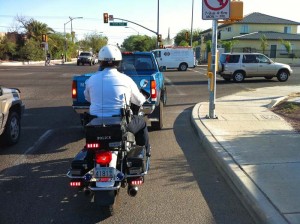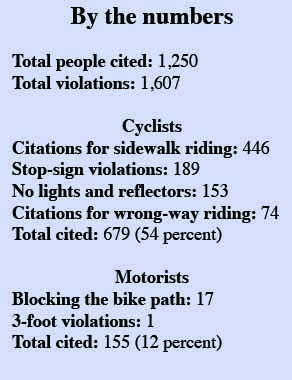 The Tucson Police Department wrapped up their month-long bicycle and pedestrian safety campaign, but additional funds from the Governor’s Office of Highway Safety will allow them to continue the campaign throughout the year.
The Tucson Police Department wrapped up their month-long bicycle and pedestrian safety campaign, but additional funds from the Governor’s Office of Highway Safety will allow them to continue the campaign throughout the year.
According to Sergeant Jerry Skeenes, who has been in charge of the campaign, the department will spread the money out over the rest of the year to keep the awareness up.
“It won’t be quite as intense,” Skeenes said.
The original funding ran out on Sept. 23 and resulted in over 1,600 tickets being written.
Skeenes said past targeted enforcement campaigns were the result of complaints from people in the community, which meant they were going out and trying to correct a problem. This time they were given the money and could use it how they saw fit.
“We were not told how to do it,” Skeenes said. “They just gave us money and told us to make it safer for bicyclists and pedestrians.”
 Because of the flexibility, he said they could work with the bike community to enforce the laws that protect cyclists.
Because of the flexibility, he said they could work with the bike community to enforce the laws that protect cyclists.
Erik Ryberg, an attorney representing bicyclists and a critic of TPD’s past actions against bicyclists, said he was pleased with the results from the campaign but said there was still room for improvement.
“It is an immense improvement from what has been occurring in the past,” Ryberg said.
He said he was glad to see the police department responded to cyclists’ complaints about the Mountain Avenue and Grant Road intersection.
“That is an example of TPD listening to bicyclists,” Ryberg said. “As far as I know, this is pretty much the first time that has ever happened.”
He was equally happy the officers tried to find motorists who violated the three-foot rule.
“It is a huge step forward that TPD is even considering these kinds of operations,” he said.
Despite the improvement, Ryberg said he still saw officers setting up at the Fourth Avenue underpass, ticketing cyclists who weren’t just blowing through the intersection but who also weren’t coming to a complete stop either. He said that type of behavior isn’t what is causing injuries.
“I think we should remember that most of the time, when cyclists are injured it is because of a motorist violation,” Ryberg said.
Skeenes said there were both some bright spots and challenging situations during the enforcement.
According to Skeenes, the cyclists who were stopped were more generally more aggressive and angry than motorists who know they violated the law. Many of the cyclists thought they were actually riding safely and that the laws were wrong.
Pima County bicycle and pedestrian program manager Matt Zoll also works closely with the bicycle ambassadors who helped educate cyclists as well as the officers who were part of the enforcement.
Skeenes said handing out the information provided by the bike ambassadors was helpful in showing those cyclists why the way they were riding is dangerous.
Zoll said the point of having the ambassadors out there was to educate, not be an extension of the police.
“We are just there as a resource,” Zoll said. “We are the soft approach.”
Skeenes said he was pleasantly surprised by the support he received from the majority of the bike community.
“I never had a group of people that actually worked with us like the bike community did,” Skeenes said. “That was just amazing how great the support was. We could work together to achieve a goal of trying to make it safer for cyclists. I’ve been here for 16 years and that was very impressive.”
Ryberg said overall he was happy with the enforcement and thinks the bike community should be proud.
“I think it is important for bicyclists to be proud of the fact that we are actually making a dent in the behavior of our law enforcement agency,” Ryberg said.
Ryberg hopes the changes will continue and become even more pronounced as the police department spends the additional $30,000 they received.
“I hope they will think hard about how to spend this money in the most efficient manner to protect bicyclists,” Ryberg said. “If they are measuring their success by how many tickets they write then they are going to go to Fourth Avenue and University and they are going to write tickets all day long. If they measure their success in how much of a dent they make in the population of injured bicyclists, then they are going to look at things like headlight violations, wrong way riding and the kinds of violations motorists commit that put bicyclists in danger.”
Zoll said he wants to continue working with TPD to develop a plan for spending the rest of the money.
“My hope is that we could sit down and talk about the program and how we can help more,” Zoll said. “It would be nice to try to do this as carefully as possible and as proactively as possible.”
Editor’s note: The data provided by TPD doesn’t always make a distinction between cyclists, pedestrians and motorists. Therefore the numbers may be off slightly.

I would like to know how many drivers would have been ticketed for stop-sign violations (as compared to the 446 cyclists).
A few of those 189 stop-sign violations could actually be cars, but according to the police, the majority are cyclists.
Where are the other 34 percent of citations on that ‘by the numbers’ chart? Did they ticket 400 pedestrians for j-walking?
Also, like Erik said, still heard too much about stop sign violations.
And, I really wish cops would just have a box of lights and give them to cyclists they pull over without them.
@Carolyn, 446 was number riding on the sidewalk… I hope there weren’t that many cars driving on the sidewalk.
James, the rest were pedestrian violations. Violations like jaywalking and crossing on a red.
I meant to add a disclaimer to the box that they aren’t exact because the police don’t always break them down into motorists/cyclists/ped groups.
As Erik said in the article, I hope that this money is really used to target the behavior that really causes problems, rather than just to write as many tickets as possible for trivial violations. I got a ticket for not coming to a complete stop near 4th and University during the past month, as did a fair number of other people. While I was waiting for the officer to write my ticket, I watched numerous cars roll through the same intersection going at least the speed that I did. And by the time I left 4th Ave in the evening, when at least a few of the drivers on that road were a little tipsy, there were no officers to be seen. At http://azbikelaw.org/blog/there's a listing of all cyclist fatalities in AZ, and that makes it pretty clear what the causes of cyclist deaths (and presumably lesser injuries as well) are–the majority are due to unsafe drivers, some are due to totally stupid and clueless cyclists, and as far as I can tell none are due to cyclists who may not come to a complete stop but otherwise respect right of way and check that things are clear before proceeding.
Not perfect, but definitely a big improvement
TPD has merely altered their tactics from last year. They focused on different behaviors for better PR and to be more palatable to a certain group of the bicycle community, but are those behaviors being reduced significantly? TPD will just collect the money. What a deal-they get money (a grant) to collect money (tickets) supported by taxes (mo money). Bicycles are an easy target for this form of tax. I don’t buy any sincerity from TPD.
From the “Ignoring the Rules ‘Cause we Can” department: Last week I was WALKING my bike on the sidewalk on the Rillito River overpass at Campbell. I was suddenly startled by loud walkie-talkie garble right behind me,and turned around to find two Tucson bike cops RIDING on the sidewalk. Not only were they violating the cycling laws they were on the streets to enforce, but they were endangering a pedestrian on a very narrow walkway. Aside from their radio noise, they did not even announce their approach. Was this was an isolated incident? Let’s demand that all bike police practice what they preach, and rule by example.